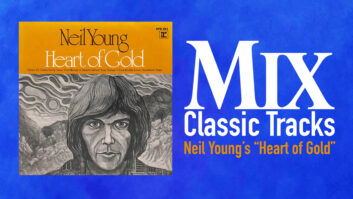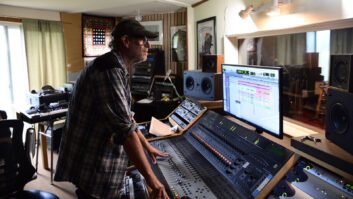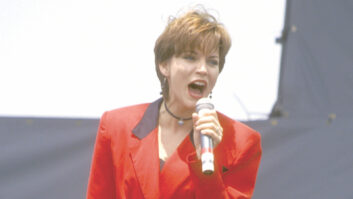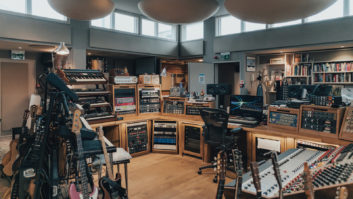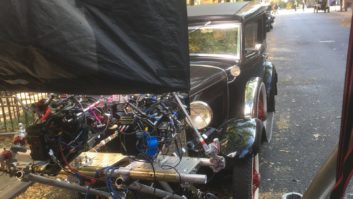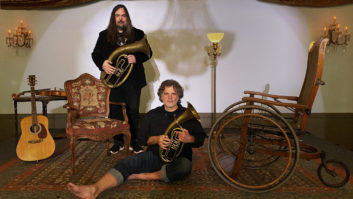“Beard” won my respect years ago by coming to Memphis and adding local bands in rotation on playlists at the 100,000 watt WZXR-FM 103 AOR station. He showed me that you didn’t have to give up your ears and enthusiasm for regional music to be an MD at a large station. His years of quality work landed him a spot in the permanent radio exhibit in the Rock and Roll Hall Of Fame. Here, he tells us why “terrestrial radio” is due for an overhaul. What do you think? E-mail us at [email protected] —Rick Clark
When the editors of Mix magazine invited me to contribute to a piece they originally titled “Give Us Our Radio Back,” I didn’t have the heart to tell them that I really agree with the premise. Sure, I realize what the imperative statement is meant to imply: a halcyon era in American radio that roughly parallels the rock’n’roll era, from the late 1950’s to the mid-1990’s, where a broad diversity of musical styles & artists could be heard, along with news, sports and local information, often all on the same station for free.
As America grew in the past half of the century, the local radio stations proliferated to over 13,300 by the close of last year. Not unlike the off-shoots of Mix magazine for its publishers and their competitors, local radio stations were encouraged to narrow their appeal through content programming that was aimed at a particular hypothetical listener. But the single biggest change that has affected terrestrial radio has been the deregulation by Congress and its enforcement agency, the Federal Communications Commission, of who can own and operate the nation’s radio and TV stations and how many. Deregulation certainly is not unique to broadcasting. The Reagan Era will always be known for deregulating the Bell telephone industry, as well as the airline industry. And when the administration changed to a sax-blowing Democrat in the White House, deregulation (seen as pro-business by some) simply found a sympathetic ear in Congress, resulting in the TELECOM Act of 1996.
Among many the things, this removed the cap on the sheer number of radio stations any one company could own nationwide. And for the first time, allowed one company to own and operate multiple stations concentrated in a single town or city.
Nationwide, and for the first time, one company could be allowed to own and operate multiple stations concentrated in a single town or city. Again, this free trade philosophy is one and the same which allowed a Canadian whiskey exporter (Seagram’s) to sell its record company/entertainment conglomerate, which it had purchased from a Japanese electronics multi-national (Matsushita) to a French multi-national (Vivendi), so that when you purchase the new Peter Gabriel CD, or take your kids on vacation to Universal Studios in Orlando or Southern California, the money is deposited to a bank next door to the Louvre.
Nothing else in our Second Millennium lives is the same; why should terrestrial radio be an exception? Actually, terrestrial (land-based transmitter) radio is the least evolved of the major media and is way overdue for an overhaul. The digital revolution that dawned in film and recording studios in the late 1970’s –early 1980’s did not begin to appear in U.S. radio stations until the late ‘80’s for compact disc playback and DAT recording, the mid-90’s for hard-disk recording on DAWs. The basic AM (amplitude modulation) and FM (frequency modulation) are now ancient technologies, fraught with inherent limitations of bandwidth, fidelity, interference and coverage area. IBOC (In-Band, On-Channel) digital transmission, grudgingly adopted by some (but certainly by no means all) terrestrial broadcasters won’t make a significant improvement to the listening experience and IBOC will have no impact whatsoever on the program content of terrestrial radio. IBOC is far too little, way too late.
“GIVE US OUR RADIO BACK”?
We should demand better. The FM progressive programming that revolutionized American radio from 1968 to the mid-90’s did NOT look back to AM, neither for technological delivery nor for content. On the contrary, we FM pioneers rejected and eschewed everything about AM. We built something completely new based on then-superior technology (full-frequency, static-free, stereo FM) and content no one else offered (Album rock, folk, blues, jazz, country, reggae & anti-Djs who didn’t scream & jive). It was this combination of technical innovation AND unique programming that served the population better than ever before.
So what does all of this have to do with the music business today? Well, as Sony Music lays off 400-1,000 employees and closes regional branches around the country, I’ll tell you – let’s call it Redbeard’s Radio Paradox #1:
“The restriction by radio of a diversity of musical styles, a short-term repression of expression, if you will, actually breeds innovative vital music.” The motive for that musical embargo, whether it’s some insidious McCarthyistic socio-political agenda, or purely profit-driven, is irrelevant . The net effect, great music, is the same. And this paradox is by no means limited to America. Actually, I first noticed it among British and Irish musicians when I would interview them on the radio. I marveled at how a country with the population size of the UK could so disproportionately dominate the American charts, from the Beatles in 1964 up through the late 1980’s. To a person, everybody from Paul McCartney, George Harrison, Mick Jagger, Keith Richard, Robert Plant and Jimmy Page, to U2’s Bono and South African Dave Matthews, all attributed their initial compulsion to MAKE music to the fact that they could not hear American music played on the sole government controlled radio station, such as the BBC, that served their locale.
It’s small wonder that the Beatles were spawned, not in London, but in Liverpool, a Western port city where Yank servicemen would first land, then sell their used Little Richard, Chuck Berry, Muddy Waters, Howlin’ Wolf and Bo Diddley records for a pack of smokes and a pint. Unable to hear these on the radio, John Lennon and Richard Starkey and Stu Sutcliffe would mine these treasures at Liverpool record stores, run by the likes of Brian Epstein, then do their best to mimic the American’s sound at the Pally dances on Saturday afternoon.
“And we (the Beatles) did the B Sides!,” McCartney emphatically told me. “All the other pub bands would copy the ‘A’ Sides, but we wanted to play the deep R&B. Sometimes John (Lennon) couldn’t quite make out the words, though, so he’d just make ‘em up. Nobody knew!”
At the same time in America, multiple commercial and non-commercial radio stations made the radio restrictions more subtle, by omission, even if the posters exhorting “Don’t Play Race Records” wall-papered the studio walls of many 1950’s-era American radio stations.
Gregg Allman told me, “A boyhood friend, Floyd Miles, took me literally across the tracks to this little store, a combo barbershop, grocery and liquor store, that sold records out of a wooden box. I think they sold it for a buck! Now back then, 1960, it wasn’t cool to be goin’ over to ‘Black Town’, but my friend introduced me to (the sound of) Sonny Boy Williamson, Howlin’ Wolf, Jimmy Reed and Otis Redding. And the music was gutsy, man, and it had something to hold on to, ya’ know.? I just became in totally infatuated with it. And every dime I got went to the record store. And I would sit at home learning them licks, learning to play (guitar) and by now I really had the fever bad. And my brother, Duane, was gettin’ it. Then he quit school and passed me up in the afternoon! He was a natural man!”
So you see, whether it was The Quarrymen or the Allman Joys, radio’s most significant contribution may have been one of omission. Radio did not service these young men “in the public interest,” so they simply created their own musical dialogue with others.
GIVE US OUR RADIO BETTER!
Now before you infer that I’m absolving terrestrial radio from any complicity in the state of the music business, I’m not. What I’m saying is, if you want useful answers, you have to be and frame the issue with the right question. Where is the technical innovation combining with unique content heretofore unavailable to mass consumption. The internet certainly has enormous potential as a two-way interactive distribution system and most agree that most technical limitations, such as uncompressed data and portability will be mastered in due time. Attracting the content provider and the programmers to make sense of it all, will have to be done the old fashioned way: they’ll have to earn it.
The endeavor that combines the tech superiority with the premium content and presentation, right here right now, is satellite radio. The two satellite radio services, XM and Sirius, have invested approximately $3 billion to offer fidelity (CD quality all digital end to end), portability (car, home, office), lack of irritability (virtually no commercial interruptions), and overwhelming over-the-top choice (both XM and Sirius offer 100 separate radio formats. Hindu Hits anymore?). The programming is shaped by a hand-picked cadre of successful radio veterans, as well as youngbloods who intend to use every crayon in the box. The radio’s are affordable (about $250) and the service is $10 a month. (Sirius is slightly higher.)
If I was a songwriter/musician, I’d have both XM’s “Unsigned” Channel (with nothing but unreleased/indie recordings, 24/7) & Sirius’ counterpart on speed-dial, and their snail mail and email address memorized. Plus, it’s one-stop shopping for A&R when the travel budget dries up!
GIVE US OUR RADIO – BEST!
While the DVD is revolutionizing home entertainment theater, and providing the first dramatic improvement in consumer sound reproduction since the introduction of the compact disc twenty years ago, realize that satellite radio – and only satellite radio – has the capability now to provide discrete 5.1 Surround sound, such as Dolby Digital, DTS or DVD-Audio. I button-holed the XM scientists who actually developed the chipset that allows their radio to work, and they assured me that the technology that provides two-channel stereo to any of their 100 stations can easily be adapted to carry six (five channels and a sub). It’s simply a matter of allocating their finite bandwidth (three stereo stations could fit into the channel space of one 5.1 surround station). And the car environment, XM and Sirius’ preferred marketplace initially, is ideal for surround sound.
Major league baseball shares many parallels with terrestrial radio. Owners and players/workers focus entirely on each other, quite publicly feuding over who deserves the larger potion of the wishbone, while the focus should always be on the public itself. Like baseball fans, the terrestrial business model is based on an entire generation of radio consumers that are expected to listen, regardless of the excellence of play on the field/on the air.
Closer
So it sees the quality, intensity, and validity of the musical “scene” that emerges is inversely proportional to the quality with which the radio serves the community. If my theory is correct, then the music industry has a bumper crop of songwriters and musicians just on the horizon. King Harvest will surely come!

